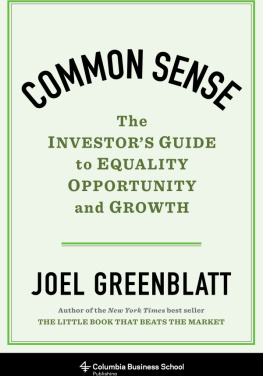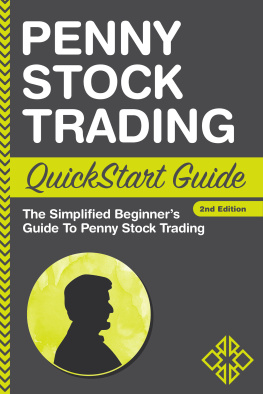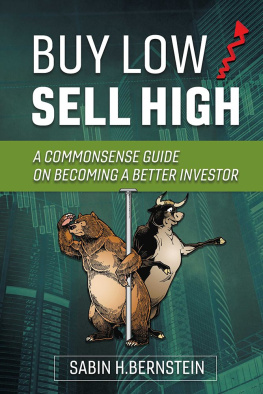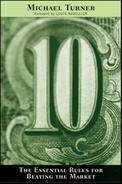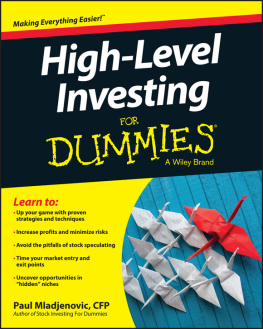All rights reserved worldwide.
Greenblatt, Joel.
p. cm.
Includes index.
1. StocksUnited StatesHandbooks, manuals, etc.
2. InvestmentsUnited StatesHandbooks, manuals, etc. I. Title.
ACKNOWLEDGMENTS
As with any work of this kind, many people deserve the blame. Of course, the ultimate responsibility for errors, omissions, misstatements, or misguided advice rests with some guy from Cleveland who no one can seem to find. As a consequence, I have no choice but to point the finger at the following suspects:
The entire cast and crew at Gotham Capital. This includes my partner in crime, Daniel Nir, who I had the good fortune of plucking from the jaws of Harvard Business School at the inception of Gotham Capitalhe is one of the primary reasons for Gothams success, a major contributor and supporter of this project, and still one of my all time best picks; my partner, Robert Goldstein, whose brutally honest (and, unfortunately, fair and insightful) comments made this book far better than it would have beenalso special thanks for his unparalleled contributions to many of the examples found on these pages (and to the profits that went with them), including the discovery of Charter Medical and his exceptional work on Host Marriott and Liberty Media; my partner, Edward (Ned) Grier, for both his helpful comments and superior research efforts on many of the case studies found here in, including General Dynamics and Strattec. While each of these extraordinary investors could have compiled a spectacular investment record without the aid of any partners, I feel privileged to have had the opportunity to work with such a talented group of friends.
Speaking of talent and friends, I would also like to give special thanks to Gothams dedicated and fearless head (and only) trader, Lisa Alpert; our chief financial officer and all around nice guy, Bruce Berkowitz (no relation to the Wells Fargo investor by the same name); and our special and multi-talented office manager, Alison Jarret.
Two more people deserve special mention as members of the Gotham family. The first, Bruce Newberg, has truly been a full partner in Gothams success. He is not only responsible for raising the start-up capital that made Gotham possible, but for contributing a never-ending stream of sage advice, exceptional investment ideas, and overwhelming friendship as well. Everyone should be lucky enough to have such a loyal and good friend. The second Gotham family member also happens to double as my sister. Linda Greenblatt has been the primary sounding board and constructive contributor to this book. Its amazing that even after fifteen readings, she still managed to laugh in all the right places and found the time to make her new investment partnership, Saddle Rock Partners, a major success. Her infinite patience, dedication, and intelligence has had a dramatic effect on the final result. I absolutely couldnt have finished this project without Lindas help.
Other likely suspects, owing to their significant contributions and friendship, include: John Scully of Hamilton Partners and Columbia Business School, a mentor and friend from my Halcyon days; Eric Rosenfeld, Managing Director of Oppenheimer & Co.; Jeffrey Schwarz, Managing Partner of Metropolitan Capital Advisors; Richard Pzena, Pzena Investment Management; Mitch Julis, Managing Partner of Canyon Partners; Seth Klarman, President of the Baupost Group; Joseph Mazzella, my attorney and a partner at Lane, Altman & Owens; Robert Kushel, my broker at Smith Barney; Mark Gimpel, Esq., for my glorious Apache Relay memories; Major Gary E. Warren, U.S.M.C. for his counting humor; and Rabbi Label Lam, for his invaluable directions towards the stake in the sand, and specifically, for his currency of life thoughts in the final chapter.
Special thanks also to Bob Rosenkranz, chairman of Delphi Financial Group and managing partner of Acorn Partners, for his unrivaled support of Gotham throughout the years; Ezra Merkin, our partner at Gotham for two and a half years during the 1980s; and Stan Kaplan, Gothams head trader for our first five years.
Thank you also to Bob Mecoy, my editor at Simon & Schuster; Sandra Dijkstra, my agent; and Guy Kettelhack, for his assistance with the original book proposal.
Extra special thanks for the love, support and encouragement of my entire family, each of whom pitched in to add significantly to the final result (me and the book): my wonderful parents, Allan and Muriel Greenblatt; Richard and Amy Greenblatt; Drs. Gary and Sharon Curhan; and my in-laws (the in-laws) Dr. George and Cecile Teebor.
Grateful appreciation also to my son, whose searing question, So, what are you, Dad? Policeman? Fireman? What? served as a major inspiration for the completion of this book. At least, now I can respond, You know what Dr. Seuss does, right?
Finally, to Julie, the love of my life (and my wife), and our four unbelievable children, thank you for the gift of each precious day together.
TO MY WONDERFUL WIFE, JULIE,
AND OUR FOUR MAGNIFICENT SPINOFFS
Chapter 1
FOLLOW THE YELLOW
BRICK ROAD
THEN HANG A RIGHT
It doesnt make sense that a book can teach you how to make a fortune in the stock market. After all, what chance do you have for success when youre up against an army of billion-dollar portfolio managers or a horde of freshly trained MBAs? A contest between you, the proud owner of a $24 how to book, and these guys hardly seems fair.
The truth is, it isnt fair. The well-heeled Wall Street money managers and the hotshot MBAs dont have a chance against you and this book. No, you wont find any magic formula in chapter 8, and this isnt a sequel to How to Succeed in Business Without Really Trying, but if youre willing to invest a reasonable amount of time and effort, stock market profits, and even a fortune, await.
Okay: Whats the catch? If its so easy, why cant the MBAs and the pros beat your pants off? Clearly, they put in their share of time and effort, and while they may not all be rocket scientists, there arent many village idiots among them either.
As strange as it may seem, there is no catch. The answer to this apparent paradoxwhy you potentially have the power to beat the pants off the so-called market expertslies in a study of academic thinking, the inner workings of Wall Street, and the weekend habits of my in-laws.
We start with some good news about your education: simply put, if your goal is to beat the market, an MBA or a Ph.D. from a top business school will be of virtually no help. Well, its good news, that is, if you havent yet squandered tons of time and money at a business school in the single-minded quest for stock market success. In fact, the basic premise of most academic theory is this: It is not possible to beat the market consistently other than by luck.


